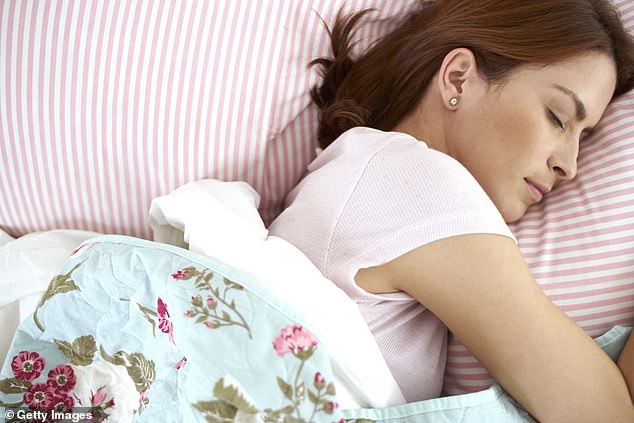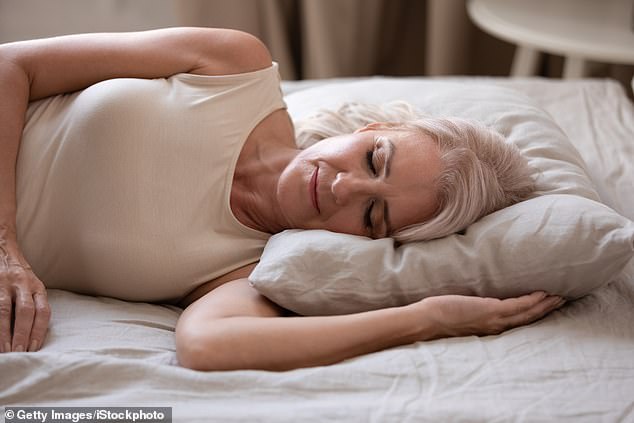How the way you sleep can give your face wrinkles – and even change your lip shape
We all know that if you want to avoid wrinkles, you should stay out of the sun, stick to a skin care routine, not smoke and eat healthy.
But did you know that something seemingly innocent that you do every day, or, to be precise, every night, can give you lines and even change your facial features?
How you sleep and the impact it has on your face has become a feverish topic of conversation on social media. In a TikTok video that has since gone viral, American beauty influencer Marianne claimed her uneven lip shape was caused by sleeping on her side.
The post has been viewed almost 15 million times and has generated almost 7,000 comments from followers who seem to buy her theory.
But even though such an idea sounds far-fetched (and, frankly, terrifying), is it possible that your sleeping position can actually change the symmetry of your face?

While such an idea sounds far-fetched (and frankly terrifying), is it possible that your sleeping position could actually change the symmetry of your face? (stock image)
When it comes to wrinkles, I’m afraid to say the answer is probably yes.
But when it comes to your characteristics, the experts are divided. Kate Kerr, clinical facial expert and director of Kate Kerr London Clinic (katekerrlondon.co.uk) has no doubt that sleep can have a significant impact on both your face and décolleté.
“According to a study in the Aesthetic Surgery Journal, the forces of compression, tension and sheer pressure exerted on our faces during sleep can lead to facial disfigurement,” she says.
‘Such distortion manifests as vertical creases and creases when we sleep on our sides or stomach.’
These vertical folds may start out as temporary temporal folds – often along the lines extending from the nose to the corners of the lips – but over time, as the skin ages and loses its ability to bounce back, they can become permanent .
The same is true elsewhere on the body, where the effects of gravity come into play. ‘When we lie on our sides, our breasts can sag, resulting in noticeable vertical lines on the décolleté,’ says Kate.
Of course, no one is born with a perfectly symmetrical face, but luckily she says the risk of ending up alarmingly crooked is small as it is ‘unlikely to have a significant impact on the symmetry of the eyes and lips’. Relief.
However, oculoplastic surgeon Dr. Maryam Zamani (drmaryamzamani.com) thinks sleep may play a role in facial asymmetry.
“Sleeping on your side can cause repetitive pressure on a specific area, causing folds and exacerbating the appearance of lines and wrinkles on the favored sleeping side,” she says.
‘This worsens the asymmetry of the eyes, lips and face.’
This could mean that one eye has a slightly different shape or height, or that one side of the lips is lower than the other. Dr. Zamani continues: ‘As we age, asymmetries become more apparent and in addition, the skin’s elasticity decreases, meaning static lines can take longer to hydrate and bounce back after a night’s sleep.’
It’s the same as laugh lines: everyone has them, but the older you are, the more likely they are to remain after you’re done smiling and eventually become permanent.
And while side sleeping is the most common position, those of us who sleep on our stomachs are apparently in for an even more unpleasant surprise.
‘Sleeping on your stomach is generally considered the least healthy sleeping position for your skin,’ says Dr Dianni Dai of Elan Laser Clinics (elanlaserclinics.co.uk).
“Your face is pressed against the pillow, which can cause wrinkles and acne (just by rubbing your skin against the pillow). This also applies to the décolleté area, which is similarly affected by friction with the pillow and sheets.’
In fact, the only people who might feel a little smug reading this are those who sleep on their backs.
“If you sleep on your back, there is obviously no friction against your face,” says Dr. Dai. ‘And it also improves circulation, which can help prevent fluid build-up in the face, reducing the risk of bags and dark circles under the eyes.’

Of course, no one is born with a perfectly symmetrical face, but fortunately she says the risk of ending up alarmingly crooked is small as it is ‘unlikely to have a significant impact on the symmetry of the eyes and lips’ (stock image)
Like all the practitioners we spoke to, she said she sees many clients complaining that their faces are asymmetrical. But ‘usually they don’t know that this is related to their sleep. They usually discuss sagging skin on one side, or more noticeable wrinkles on one side, or in some cases uneven lips (which, due to sleeping position, may be thinner or lower on one side than the other) that they discuss. I would like to be corrected with filler and then I will ask which side they sleep on. It usually has something to do with that, which most people are baffled about.”
So what do you do if you’re a lifelong side or front sleeper?
The obvious answer would be to sleep on your back – if only it were that simple.
‘When we jump into bed, we can make a conscious decision about the position we want to rest in, but once we’re asleep, we have little to no control and can move to a new position about 20 times on average. every night,” says Kate Kerr.
“It’s difficult to change positions if you’re used to sleeping on one side,” adds Seendy Ramoutar, an experienced nurse at Therapie Clinic (therapieclinic.com).
‘I often advise my clients to use a neck or travel pillow in bed for a few days.
‘This means they no longer roll to the side and they gradually start sleeping on their backs.’
If you’re used to sleeping on your stomach, Dr. Dai suggests gradually transitioning to a different sleeping position.
“Start by using a thinner pillow to reduce pressure on your neck and sleep on your side with a supportive pillow,” she advises.
But as Seendy notes, some people can’t sleep on their backs for medical reasons — for example, if you have obstructive sleep apnea, where your tongue can block your air passage while you sleep. In those cases, she has another suggestion.
‘I advise them to start the night on the opposite side from where they normally sleep. They will end up rolling onto their preferred side, but that will have provided some relief, bringing some degree of balance back.”
However, the quality of your sleep is also crucial to the health of your skin, so if changing your sleeping position only leads to you tossing and turning all night, there are other changes that can help.
Satin or silk pillowcases, which are less likely to cause friction with the skin, are often advised – and some people swear by devices such as the cushion bra (£65, sleepandglow.co.uk), a silk pad that sits between the breasts to prevent the skin wrinkles there.
Dr. Zamani says your skin care regimen can help too.
‘Applying a moisturizer or night cream before going to bed can help hydrate your skin and create a barrier against friction, reducing the chance of sleep wrinkles.’
She also advocates drinking plenty of water during the day – ‘this can help keep your skin hydrated, making it more resistant to the effects of sleep position’.
But even if you make all these adjustments, can you really turn back the clock on decades of sleeping in one position?
Yes, but at some point you will probably need professional intervention.
Dr. Dai says the most effective treatment for deeper lines caused by your sleeping position is “a supportive filler.” Hyaluronic acid-based fillers hydrate, strengthen and support the skin.
‘These fillers also ensure that sleep wrinkles are less likely to reoccur, given the support that is now provided from within.’
For finer lines, she recommends moisturizing using skin boosters or mesotherapy, which involves making many small injections of hyaluronic acid into the skin to stimulate collagen production and draw water to the skin’s surface.
Although the way you sleep can ultimately give you wrinkles, there are plenty of ways to solve the problem.
So there’s really no need to worry about it.
